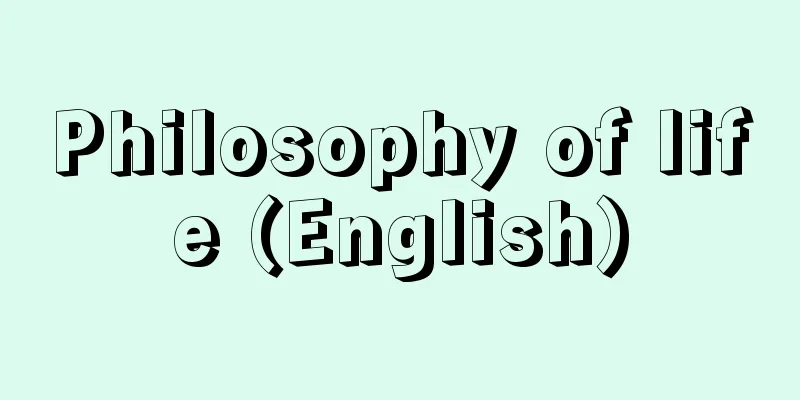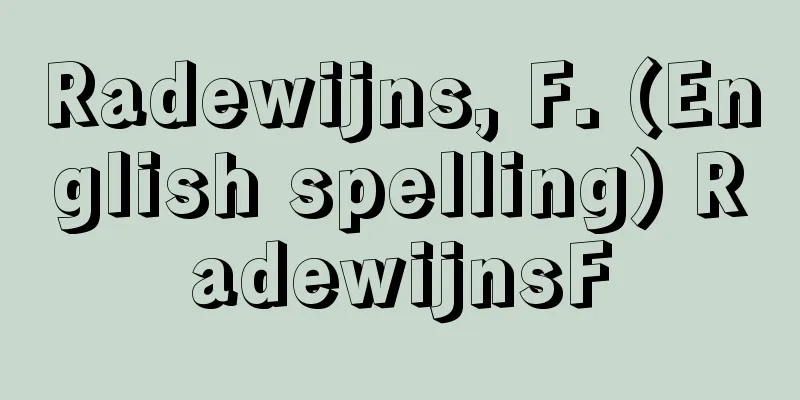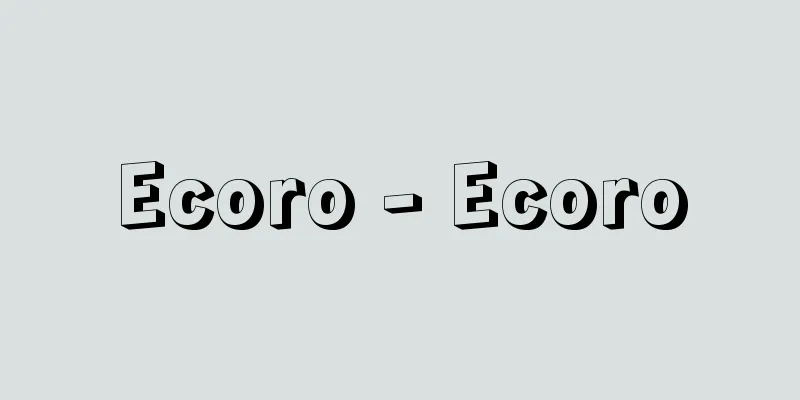Philosophy of life (English)

|
A general term for a series of philosophical tendencies that developed in Europe from the latter half of the 19th century, especially from the end of the century until around the time of World War I in the 20th century. It arose as a movement opposed to the prevalence of positivism, influenced by the development of empirical science since the latter half of the 19th century, or materialistic thought. Specifically, the philosophies of Schopenhauer and Nietzsche, Dilthey, Eucken, Simmel, Bergson, and others are usually considered representative. Bergson in France had Maine de Biran and Labesson, who were neo-spiritualists, as his forerunners. In America, W. James is usually considered one of the founders of pragmatism, but he shares many essential points in common with Bergson's ideas. A similar tendency can be pointed out in T. E. Hume in the UK and Kitaro Nishida in Japan. If we take the concept of the philosophy of life a little broader, it would be permissible to include the above-mentioned series of people in that tendency. In any case, the common feature of these philosophers is that they believe that the "life" of humans, or of living things including humans, and even of the entire universe, cannot be grasped by the mesh of rational thinking typified by positive science, but is rather obscured. The substance of "life" is sometimes considered to be the "dark will to life" (Schopenhauer) or the "will to power" (Nietzsche), or it is also understood as "pure duration," "the leap of life" (Bergson), "pure experience" (James, Nishida), or "spiritual-historical life" (Dilthey, Eucken), and each person has a different nuance even though they are all philosophies of life. However, they are on the same track in that they focus on the totality of the universe and human life as something that escapes the mesh of proof by rational and scientific thinking, and cannot be grasped by the objectifying and one-sided knowledge of modern science, and aim to enter into it by returning to intuition or experience and its understanding and understanding, which are distinct from (natural) scientific knowledge, and from a macroscopic perspective, they form a single trend. The significance of the philosophy of life is that it does not focus on the rationalization of life in all areas of life that is spreading throughout Western civilization as it transitions from modernity to the present day, but rather focuses on the negative aspects of this, which flattens, divides, and suffocates life as a whole, and attempts to trace back to the foundation of life that cannot be fully grasped by the mesh of rational thought, regain a sense of the overall flow of life that runs through the universe and history, and revive the life that is inherent in philosophy. This is why the thoughts of those who represent this position all have a certain "idealistic" tinge. Even in today's world, where the situation is becoming increasingly severe, the flow of thought that they have opened up never ceases, and it seems that they are searching for a way forward, aided by new and sophisticated methods such as phenomenology, hermeneutics, and semiotics. [Megumi Sakabe] "The Philosophy of Life" by O.F. Borneau, translated by Haruo Toda (1975, Tamagawa University Press) " "The Philosophy of Life" by Dilthey, edited by H. Noll, supervised by Akira Kuno (1987, Ibunsha) [References] | | | | | | | | |Source: Shogakukan Encyclopedia Nipponica About Encyclopedia Nipponica Information | Legend |
|
19世紀後半、とくにその末期から20世紀の第一次世界大戦前後にかけて、ヨーロッパで展開された一連の傾向の哲学の総称。19世紀後半以来の実証科学の発達に影響された実証主義、あるいは唯物主義的思想の盛行に対立する動きとしておこった。具体的には、ショーペンハウアー、ニーチェを先駆者として、ディルタイ、オイケン、ジンメル、ベルクソンらの哲学が通常その代表的なものに数えられる。フランスのベルクソンは、メーヌ・ド・ビラン、ラベッソンら新心霊主義(スピリチュアリズム)の人々を先駆者としてもつ。またアメリカには、通常プラグマティズムの創始者の一人に数えられながらもベルクソンの考えと本質的な点で多くの共通点をもつW・ジェームズがある。イギリスのT・E・ヒュームやまた日本の西田幾多郎(きたろう)にも同様の傾向を指摘できる。生の哲学の概念をすこし広くとれば、前記の一連の人々をもその傾向に含めて考えることが許されよう。いずれにせよ、これらの哲学者たちに共通する特徴は、人間の、あるいは人間をも含めての生物の、さらには宇宙全体の「生」は、実証科学を典型とする合理的思考の網の目によってはとらえられず、むしろ覆い隠されてしまうと考えるところにある。「生」の実体は、あるいは「生への暗い意志」(ショーペンハウアー)、「権力への意志」(ニーチェ)とされ、また、「純粋持続」「生の飛躍」(ベルクソン)、「純粋経験」(ジェームズ、西田)、「精神的、歴史的生」(ディルタイ、オイケン)というようにとらえられ、同じ生の哲学といっても各人各様のニュアンスがみられる。しかし、合理的・科学的思考による証明の網の目を逃れるもの、対象化的、一面的な近代科学の認識によってとらえられぬものとしての宇宙と人類の生命の総体に注目し、(自然)科学的認識とは区別された直観、ないしは体験とその把握・了解に立ち戻ることによってそれに参入することを目ざす点において、彼らは軌を一にしており、巨視的にみれば、一つの潮流を形づくるのである。 生の哲学の意義は、近代から現代へと移りゆく西欧文明の全般に広がる生のあらゆる領域での合理化に目を奪われることなく、むしろ総体的な生を平板化し分断し窒息せしめるそのマイナス面に着目して、合理的思考の網の目によってはとらえ尽くせぬ生の基盤へと遡行(そこう)し、宇宙と歴史を貫く総体的な生の流れへの感覚を取り戻し、哲学に固有の生命をよみがえらせようとしたことにあった。この立場を代表する人々の思考が、等しく、なんらかの意味で、「理想主義」的色合いを帯びるゆえんである。時代の状況がますますその厳しさを加えている今日にあって、彼らの開いた思考の流れは、それにもかかわらず絶えることはなく、現象学、解釈学、記号論等々の新たな精緻(せいち)な手法と相助けつつ、進むべき道を模索しているように見受けられる。 [坂部 恵] 『O・F・ボルノー著、戸田春夫訳『生の哲学』(1975・玉川大学出版部)』▽『ディルタイ著、H・ノール編、久野昭監訳『生の哲学』(1987・以文社)』 [参照項目] | | | | | | | | |出典 小学館 日本大百科全書(ニッポニカ)日本大百科全書(ニッポニカ)について 情報 | 凡例 |
<<: Life instinct - Lebenstriebe [Germany]
>>: Positive number - Seinosuu (English spelling) positive number
Recommend
Cavolinia longirostris (English spelling) Cavolinialongirostris
…[Tadashige Nabe]. . … *Some of the terminology t...
Acute dacryocystitis - Acute dacryocystitis
...This is a method of removing the bone wall of ...
Nankaido Earthquake - Nankaido Earthquake
Also known as the Nankai earthquake, this massive ...
Davies, AB (English spelling) DaviesAB
…Two innovative movements emerged in New York at ...
Central America - Chuo AmeriKa (English spelling)
A general term for the long, narrow region that c...
Crab-like insect - Crab-like insect
A general term for arthropods belonging to the Cha...
Saint John's
The capital of Antigua and Barbuda, the smallest c...
Kobe Steel, Ltd.
The fourth largest steel manufacturer in Japan. Th...
Ringhals
...The king cobra Ophiophagus hannah (illustratio...
reason
…The power of thought and cognition inherent to h...
Inanna
…the representative Babylonian goddess. In Sumer ...
Anshi Rebellion
The rebellion by An Lushan and Shi Siming (755-76...
Mount Isa
A mining city in northwest Queensland, in northeas...
Takanoyu [Hot spring] - Takanoyu
This hot spring is located in Ogachi Town, Ogachi ...
Ministry of Foreign Affairs Diplomatic Cable Leak Incident
However, taking into account the principle of pop...









